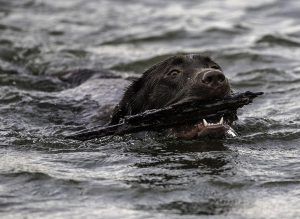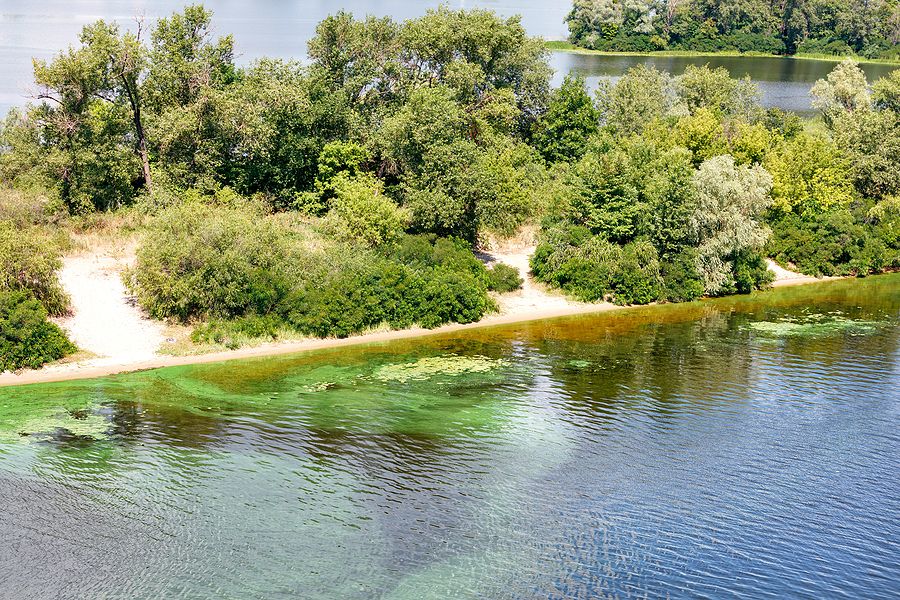Summer swimming for our canine friends is just around the corner. Who can resist the fun of watching your pup swim after the ball or toy and bring it back? Sometimes we even join them playing in the water under the hot summer sun. Inside and Out Pet Care LLC. cares about your furry family and wants to make you aware of the potential dangers lakes or ponds can present to your dogs. This is important information for your dog sitter to know as well.

What is Blue-Green Algae?
Locally in Larimer County we have many lakes, ponds and other water-ways to splash in. However there is a deadly danger lurking in some of those places. It is Blue-Green Algae which are toxic algae or harmful algae blooms. Technically, these organisms are a special type of bacteria called cyanobacteria or cyanoHABs. Although these organisms naturally occur in Colorado waters, they become a problem when they multiply rapidly, resulting in a dense cyanobacteria concentration or “bloom.”Harmful algal blooms (HABs) are overgrowths of cyanobacteria (blue-green algae) that cause water quality problems in lakes and ponds, including the occasional production of potent toxins.
These toxins can poison people, household pets, waterfowl and livestock. Because HABs are increasing in many areas, the number of dog poisonings from Cyanobacterial toxins are also on the rise. To keep your canine companions safe around local waterways, please add HABs to the safety checklist, especially in summer when you bring your dog to the beach or in the fall when waterfowl hunting with your favorite retriever.
Dogs drink this water as they swim and play. They don’t mind the musty taste of the algae at all – which makes them so much more at risk than humans.
What do HABs Look Like?
- Appears foamy or like pea soup, spilled paint, colored water; also as scum or floating mats
- Most often green to blue-green colored, occasionally red or brown, (or white, as a bloom is ending)
- Scums or floating mats that can wash up on shore or accumulate on the windward side of shorelines
What About HAB Toxins?
- Not always present in a cyanobacterial bloom
- Colorless, water soluble, powerful, fast-acting with no known antidotes
- Released as toxic cyanobacteria die off, or are consumed
- At least three types: liver toxins, nerve toxins and skin toxins
Signs of Possible Cyanobacterial Toxin Poisoning in Dogs
If your dog has been swimming in a lake or pond with a suspected or identified HAB, please closely monitor your dog for any signs of cyanobacterial poisoning (listed below), and make sure your dog sitter service has this information too. These signs can occur within 30 minutes to a few hours after exposure, depending on the size of the dog, the type of toxin, the toxin concentration and how much toxin the dog has ingested. In severe cases, dogs can show signs of cyanobacterial poisoning within a few minutes and can die within an hour of toxin exposure.
Common signs of cyanobacterial poisonings in dogs are listed below. These signs may not always appear together.
COMMON SIGNS OF HAB TOXIN POISONINGS
Liver Toxins
- Repeated vomiting (green liquid)
- Diarrhea or tarry (bloody) stool
- Loss of appetite, anorexia
- Jaundice (yellowing of eye whites, gums)
- Abdominal swelling may be tender to the touch
- Cyanosis (bluish coloration) of skin
- Dark urine or reduced/ no urine output
Nerve Toxins
- Stumbling, seizures, convulsions, paralysis
- Excessive salivation/drooling
- Disorientation, inactivity or depression
- Elevated heart rate, difficulty breathing
Skin Toxins
- Skin rashes, hives
How Can You Reduce the Risk of Dog Poisoning by Cyanobacterial Toxins?
- If possible, keep your dog on a leash near shorelines.
- Don’t let dogs wade, drink the water or eat/walk in beach debris.
- If your dog goes in the water, please remove them immediately.
- Don’t let them lick their fur or paws after getting out of the water.
- Rinse/wash them thoroughly with fresh water from a safe source if available. (i.e. bottled water or household garden hose). Otherwise a towel or rag can be used to remove algal debris.
- Use rubber gloves during pet cleaning, if possible.
- Dry them thoroughly with a clean towel or rag.
- Wash your hands with fresh water.
- Look closely for any symptoms described.
- Please notify the public health department or state natural resource management agency.
What to Do if Your Dog is Exposed
If you suspect your dog has been exposed to cyanobacterial toxins, seek immediate veterinary care. You can also contact various pet poison hotlines listed below for more information. Untreated, cyanobacterial poisonings are usually fatal in dogs. Even in cases where a poisoned dog receives prompt veterinary care, the outlook for a dog is often poor and the dog may not fully recover. Veterinary care can last a few days to several weeks.
I have read several stories in my local paper about dogs passing away before the owner can even get to the vets office. What a heart-breaking experience this has to be. What a tragic loss of your pet’s life that could have been prevented. Knowledge is a life-saver, this is exactly why we want to share this information with you.
I have listed these phone numbers I found on the Larimer County site. However I recommend that you call your personal vet if you think your pet was affected by Blue-Green Algae. In addition, look up your local Emergency Vet ahead of time and place it into your contacts on your cell phone. Time is of the essence and having this information easily accessible in an emergency could be a life saver. Your dog sitter should also have these numbers.
24-Hour Pet Poison Hotlines
- Animal Poison Control Center:
(800)-213-6680. $39 per incident fee
http://www.petpoisonhelpline.com
Also available as iPhone app - ASPCA (888) 426-4435.
$65 consultation fee
http://www.aspca.org/pet-care/animal-poison-control - Cornell Veterinary Emergency
Hotline (607)-253-3060
Talk to a Professional Pet Sitter
At Inside and Out Pet Care LLC., we care about your pets as if they were our own. We hope this information was helpful for you and your furry family. If you have any questions or need a professional dog sitter, please contact us at (970) 425-1427. You can also fill out a contact form by clicking here.

